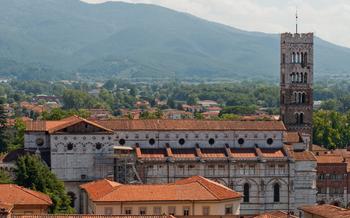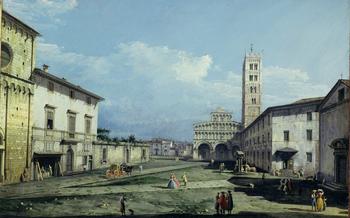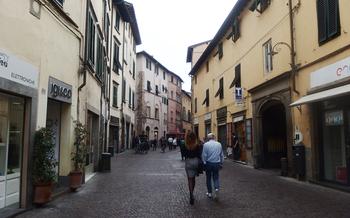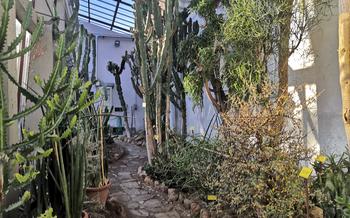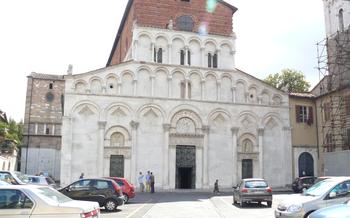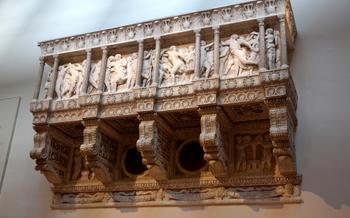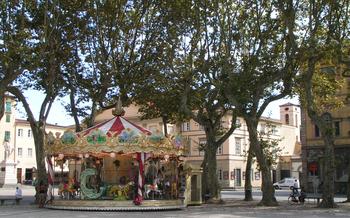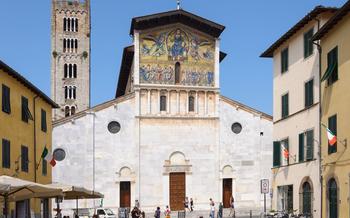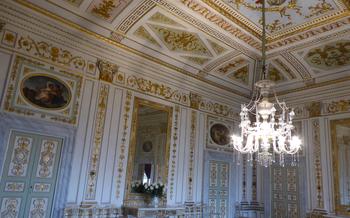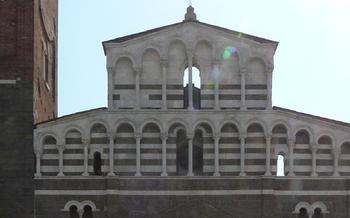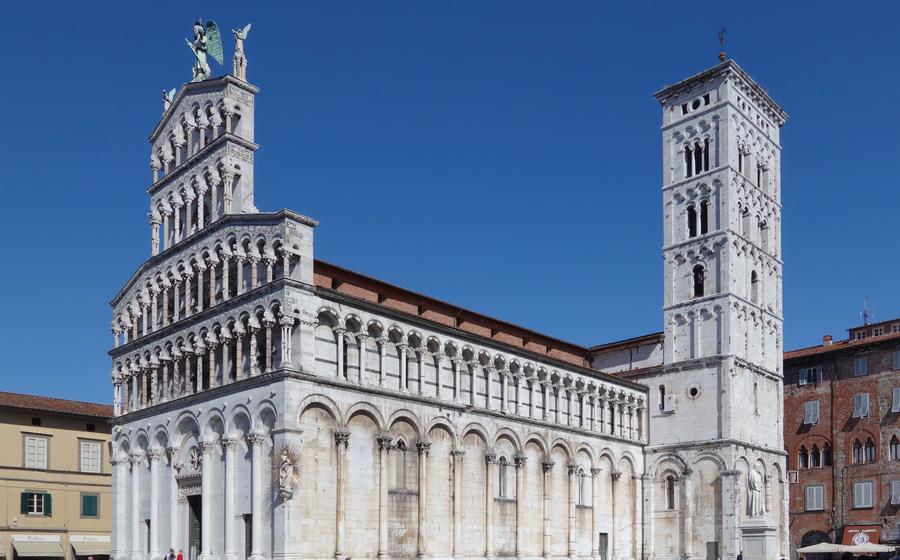
San Michele in Foro
- Lucca's Hidden Gem: San Michele in Foro
- History of the Church - A Tale of Transformation
- Architectural Marvel - An Artistic Masterpiece
- The Sculpted Facade - Symbols and Saints
- Interior Delights - A Treasure Trove of Art
- The Volto Santo - A Revered Icon
- The Sacred Relics - Venerated Treasures
- Practicalities - Plan Your Visit Seamlessly
- Exploring the Surroundings - Uncover Lucca's Beauty
- A Walk Through History - Lucca's Colorful Past
- The City Walls - A Fortified Legacy
- Local Cuisine - Tantalizing Delights of Lucca
- Events and Festivals - A Vibrant Calendar
- Hidden Gems - Unveiling Lucca's Lesser-Known Treasures
- Insider Tip - A Photography Haven
Lucca's Hidden Gem: San Michele in Foro
Nestled in the heart of Lucca, a city adorned with medieval charm and rich historical tapestry, lies a hidden gem that beckons travelers to delve into its architectural splendor and künstlerisch treasures. The Church of San Michele in Foro, a masterpiece of medieval craftsmanship, stands as a testament to the city's enduring heritage and cultural significance. Its unique architecture, exquisite facade, and precious artworks combine to create an enchanting aura that captivates visitors, inviting them on a journey through time.
The church's history is interwoven with centuries of transformation, adding layers of significance to its sacred edifice. Initially constructed as a Lombard church during the 8th century, it underwent substantial transformation during the Renaissance era. The 12th century saw the reconstruction of the facade and the addition of the bell tower, while subsequent centuries brought further embellishments, each contributing to the church's multifaceted charm.
History of the Church - A Tale of Transformation
San Michele in Foro's story is a testament to the enduring spirit of Lucca. Originally a humble oratory built in the 8th century, it underwent a remarkable transformation during the 12th century. Inspired by the grandeur of the Romanesque style, the church was reimagined as a majestic edifice, its foundations laid atop the ruins of a Roman forum.
During this period of architectural rebirth, the church's facade was adorned with intricate carvings and sculptures, reflecting the evolving artistic sensibilities of the era. Centuries later, in the 16th century, the church underwent further modifications under the direction of renowned architect Bartolomeo Ammannati. With his deft touch, the church's interior was embellished with elegant Renaissance elements, blending harmoniously with the existing Romanesque architecture.
Over time, San Michele in Foro has borne witness to the passage of history, accumulating layers of architectural styles and artistic expressions. Each era has left its mark, contributing to the church's unique charm and historical significance.
Architectural Marvel - An Artistic Masterpiece
San Michele in Foro boasts an exceptional architectural style that seamlessly blends elements of the Lombard and Gothic periods. The exterior presents a striking facade characterized by elegant arches, intricate carvings, and bas-relief sculptures. The arched portal serves as the centerpiece, adorned with a collection of sculpted figures, each narrating a biblical or historical tale.
The church's facade is a testament to the artistic prowess of its creators. The delicate tracery of the windows and the intricate patterns that adorn the exterior walls add to its visual allure. The tower, a distinctive feature of the church, stands tall, reflecting the defensive architecture prevalent during the church's early construction. Its sturdy walls and arrow slits hint at the building's former role as a fortified stronghold.
The Sculpted Facade - Symbols and Saints
The facade of the San Michele in Foro is a masterpiece of medieval sculpture, adorned with intricate relief panels that depict scenes from the Bible and the lives of local saints. These reliefs are a testament to the skill and artistry of the craftsmen who created them.
The most striking feature of the facade is the central panel, which depicts Christ in Majesty surrounded by the symbols of the four evangelists. This panel is flanked by two smaller panels depicting the Annunciation and the Visitation. The lunettes above these panels contain figures of the twelve apostles and various saints.
The iconography and symbolism of the facade are complex and multifaceted. Many of the scenes and figures depicted have multiple levels of meaning, and can be interpreted in a variety of ways. For example, the lion, the ox, the eagle, and the man, which are the symbols of the four evangelists, can also be seen as representing the four elements, the four corners of the earth, and the four seasons.
The facade of the San Michele in Foro is a true work of art, and is a must-see for anyone interested in medieval sculpture and architecture. The reliefs are a fascinating and rewarding subject for study, and can be enjoyed by people of all ages.
Interior Delights - A Treasure Trove of Art
The interior of San Michele in Foro is a treasure trove of art, showcasing a remarkable collection of artworks that spans different periods. Among the highlights are the stunning frescoes that adorn the walls, depicting scenes from the life of Christ and the Virgin Mary. These frescoes, created by local artists during the Renaissance era, are remarkable for their vibrant colors and intricate details, offering a glimpse into the artistic and religious fervor of that time.
The church also boasts an impressive collection of paintings, with works by renowned artists such as Lorenzo di Credi, Filippino Lippi, and Jacopo della Quercia. These paintings, which adorn the altars and side chapels, showcase a variety of styles and techniques, from the delicate and graceful lines of the early Renaissance to the more dramatic and expressive style of the Baroque period.
Another notable feature of the interior is the stunning stained glass windows, which fill the church with a kaleidoscope of colors. These windows, dating back to the 14th and 15th centuries, depict scenes from the Bible and the lives of saints, adding to the spiritual atmosphere of the church. The windows are particularly striking when sunlight streams through them, casting a warm and vibrant glow on the interior.
The Volto Santo - A Revered Icon
Among the treasures housed within San Michele in Foro, the Volto Santo (Holy Face) holds a prominent place. This wooden crucifix, dating back to the 8th century, is a revered icon deeply embedded in Lucca's religious and cultural heritage. Legend has it that the crucifix was miraculously carved by Nicodemus, a disciple of Jesus, from wood from the very tree on which Christ was crucified.
The Volto Santo is not just an object of artistic admiration; it is a symbol of faith and devotion, a beacon of hope and solace to countless believers. Pilgrims from far and wide flock to San Michele in Foro to venerate the holy relic, seeking blessings, comfort, and spiritual renewal. The crucifix is believed to possess miraculous powers, and its presence has been credited with numerous healings and acts of divine intervention.
The Volto Santo resides in its own dedicated chapel within the church, a testament to its profound significance. The chapel, constructed in the 14th century, is an architectural masterpiece in its own right, adorned with intricate carvings, frescoes, and stained glass windows that enhance the sacred ambiance. The faithful can be seen reverently gazing upon the crucifix, their faces etched with awe and devotion as they pay homage to this beloved symbol of their faith.
The Sacred Relics - Venerated Treasures
The church of San Michele in Foro is not only an architectural marvel but also a revered pilgrimage site, home to a significant collection of sacred relics. These relics are not mere objects of historical or cultural interest but hold deep religious significance for the faithful. Among the most notable relics is a fragment of the True Cross, believed to be a part of the cross on which Jesus Christ was crucified. This relic is enshrined in a precious reliquary and is a source of veneration for countless pilgrims who visit the church. Other relics include the bones of St. John the Baptist and St. Stephen, as well as a thorn from the crown of thorns placed on Jesus' head during the crucifixion. These sacred treasures have been carefully preserved for centuries and continue to inspire awe and devotion in the hearts of believers who visit this holy site.
Practicalities - Plan Your Visit Seamlessly
San Michele in Foro's accessible location in the heart of Lucca makes it convenient to visit. The church is usually open from Monday to Sunday during the day, with variations in hours depending on the time of the year. Admission to the church is free of charge, allowing visitors to explore its architectural and artistic treasures without any financial constraints.
To fully appreciate the church's intricate details and avoid the crowds that often gather during peak tourist seasons, plan your visit for a quieter time. Early mornings or late afternoons offer an opportunity for a more intimate and serene experience. The church staff are generally friendly and helpful, providing guidance and answering any questions visitors may have.
For a more in-depth understanding of the church's history and significance, consider joining a guided tour. These tours, often led by local experts or historians, provide insights into the church's architectural features, religious significance, and the stories behind the artworks. Guided tours typically require a small fee and can be pre-booked to ensure availability.
Exploring the Surroundings - Uncover Lucca's Beauty
Situated in the heart of Lucca's historic center, San Michele in Foro offers an excellent starting point for exploring the city's wealth of attractions. Immerse yourself in the vibrant atmosphere of Piazza dell'Anfiteatro, an elliptical piazza built on the remains of a Roman amphitheater, just steps from the church. Don't miss the opportunity to climb Torre Guinigi, a medieval tower adorned with holm oak trees, for breathtaking panoramic views of Lucca and the surrounding countryside.
A short walk from San Michele in Foro leads you to Piazza San Martino, home to the stunning Cathedral of San Martino, with its exquisite Gothic facade and impressive collection of religious artworks. Take a leisurely stroll along Via Fillungo, Lucca's main shopping street, lined with charming boutiques and local shops. Admire the elegant Renaissance-style palaces, such as Palazzo Pfanner and Palazzo Mansi.
Wander through the enchanting streets of Lucca, discovering hidden gems like the Piazza dell'Erbe, a bustling market square, and the Museo Nazionale di Villa Guinigi, showcasing a collection of ancient artifacts, paintings, and sculptures. Experience the vibrant atmosphere of Lucca's daily life as you mingle with locals in the lively piazzas, savor delicious local cuisine at traditional trattorias, and shop for unique souvenirs in the artisan workshops.
A Walk Through History - Lucca's Colorful Past
Lucca's allure extends beyond the confines of the San Michele in Foro. This enchanting city boasts a profound history, deeply rooted in medieval trade and politics. In the 12th century, Lucca emerged as a prosperous trading hub, its strategic location linking it to major trade routes. Its wealth and influence were reflected in the construction of magnificent churches, palaces, and towers, showcasing the city's architectural prowess.
Lucca's history is interwoven with notable historical events and figures. In the 14th century, the city fell under the rule of the powerful Castruccio Castracani, who transformed it into a formidable military power. The city's resilience was tested during the siege of 1512, when it successfully defended itself against the Florentines, solidifying its reputation for independence. Lucca's storied past is further enriched by the contributions of illustrious figures, such as the composer Giacomo Puccini, whose birthplace is a cherished landmark.
The City Walls - A Fortified Legacy
Lucca's city walls stand as a testament to the city's rich history and strategic importance. Constructed in the 16th century, these imposing fortifications were designed to protect Lucca from invaders. The walls, which stretch for over 4 kilometers, are one of the best-preserved examples of Renaissance military architecture in Europe.
Visitors can stroll along the ramparts and admire the city's skyline and the surrounding countryside. The walls offer a unique perspective on Lucca's many towers and churches. There are also several gates that allow visitors to enter and exit the city.
The walls have been transformed into a pleasant promenade, where locals and tourists alike can enjoy a leisurely walk or bike ride. The tree-lined paths offer shade from the summer sun and provide a peaceful retreat from the hustle and bustle of the city center.
Local Cuisine - Tantalizing Delights of Lucca
Lucca's cuisine is a testament to the region's rich history and diverse influences. Indulge in the flavors of traditional Tuscan dishes crafted with fresh, local ingredients. Savor the succulent flavors of Cinta Senese pork, a local specialty known for its rich, marbled meat. Try the Tordelli Lucchese, a unique pasta filled with a flavorful mixture of meats, herbs, and ricotta cheese. Don't miss the Farinata di Ceci, a chickpea flour flatbread that is a beloved street food.
For a truly authentic experience, venture into Lucca's charming trattorias and osterias. These family-run establishments offer a warm and inviting atmosphere, where you can immerse yourself in the local culture while enjoying delicious home-cooked meals. Be sure to sample the Zuppa di Farro, a hearty farro soup with seasonal vegetables, or the Pesce in Umido, a delectable fish stew cooked in a flavorful tomato sauce.
And no meal in Lucca would be complete without a taste of the region's renowned wines. Sample the smooth and elegant flavors of Montecarlo Bianco DOC, a white wine produced in the hills surrounding Lucca. Or opt for the robust and full-bodied Brunello di Montalcino DOCG, a prestigious red wine from the neighboring region of Montalcino.
Events and Festivals - A Vibrant Calendar
Lucca pulsates with life year-round, hosting an array of captivating events and festivals that showcase its rich cultural heritage. Dive into the infectious energy of the "Lucca Summer Festival," where renowned musicians and performers grace the stage, creating a magical atmosphere under the Tuscan sky. Stroll through the historic streets during the "Lucca Comics & Games" event, a haven for comic book and gaming enthusiasts, where fantasy and creativity collide. Experience the flavors and aromas of Lucca's culinary traditions at the "Lucca Food & Wine Festival," where local delicacies take center stage, tantalizing your taste buds with every bite. These events offer a kaleidoscope of experiences, allowing you to immerse yourself in Lucca's vibrant spirit and create unforgettable memories.
Hidden Gems - Unveiling Lucca's Lesser-Known Treasures
Apart from the renowned attractions, Lucca boasts a myriad of hidden gems waiting to be discovered. Venture beyond the main tourist areas to uncover these enchanting treasures. Explore the picturesque Palazzo Pfanner and admire its stunning frescoes. Immerse yourself in the art of puppetry at the Museo del Fumetto e dell'Immagine, showcasing a collection of vintage comics and caricatures. Escape the crowds and find serenity at the Orto Botanico di Lucca, a beautifully landscaped botanical garden. For a unique culinary experience, visit the Antica Spezieria Erboristeria Sanpiero, an old-world pharmacy offering herbal remedies and local delicacies. These hidden gems provide a glimpse into the authentic side of Lucca, allowing you to experience the city like a local.
Insider Tip - A Photography Haven
San Michele in Foro is a photographer's paradise. The church's unique architecture, intricate carvings, and ethereal light create a picturesque scene that is sure to capture the imagination. For the best results, visit during the golden hours of sunrise or sunset, when the light casts a warm, golden glow on the facade, highlighting its intricate details. Experiment with different angles to capture the church's grandeur, using the surrounding buildings and cobblestone streets to create depth and context. Photographing the church from a low angle will emphasize its imposing size and stature, while shooting from above will showcase the intricate details of the facade and bell tower. Don't forget to venture inside the church to capture the stunning stained glass windows, which cast colorful hues onto the interior, creating a truly magical atmosphere.
